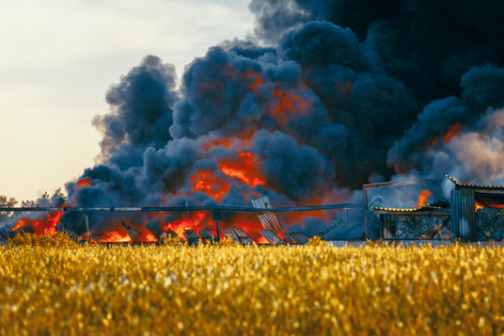Preventing fires in the recycling industry
Lesezeit: 4 Min.
31.05.2021
While the benefits of recycling have been known for years, what people often don’t realize are the risks attached. The waste industry deals with a number of potentially combustible materials, from aerosols to lithium-ion batteries. And when these are all put together and processed, the chances of a fire are high. In fact, the recycling industry in France has the highest level of reported fires of all industries. That’s why one of the leading French recyclers turned to technology to help them. The solution was made up from Hikvision technologies by MyLinks, a specialized fire detection solutions integrator.
Challenge
On top of the obvious safety risks caused by fires, there’s also environmental and cost implications, with damage to machinery that can cost millions. The industry is also regulated by an environmental organization called DREAL and recyclers are required to equip their sites with fire prevention equipment.
It’s important for any system to detect a fire as early as possible and alert relevant authorities quickly. The system also needed to account for the site’s existing operational constraints (like working time, and heat generated by end-user’s equipment (forklift, crane, truck, etc…).
In order to successfully counter the risk of fires, the system needed to integrate with the fire prevention infrastructure installed in the premises. These ranged from compartmentalization methods, like fire door management and water curtain command, to fire ‘extinction’ devices, like water cannons and solenoid valves. MyLinks supports the end-user with all these. One challenge was to design the system precisely so that the camera could work seamlessly with the water cannons. In particular the system needed to be designed in such a way so that the recycling site could cancel the water spray in a false alarm, although these are very seldom.
Solution
MyLinks installed a variety of Hikvision cameras: including Bi-spectrum Dome cameras (DS-2TD4136T), Thermography Turret cameras (DS-2TD1217-2) and Thermography Cube cameras (DS-2TA21-2AVF (or DS-2TD3017)).
A thermography dome camera is installed at the centre of a large building on site. Any object with a temperature above absolute zero emits a detectable amount of radiation, called ‘emissivity’. The camera can detect a change in the emissivity of an object or surface when temperature rises, for example, so it can prompt an alert.
In this recycling solution, water cannons are configured to respond to these changes. Water cannons are placed on the right and left of the dome camera, part of the ‘extinguishing’ process. MyLinks calibrated the devices so that when an elevated temperature is detected, the relevant cannon responds immediately by spraying water in that specific area. The enhancement of a thermal camera makes it possible to detect and extinguish very quickly when a fire does start.
However, the focus, of course, is on prevention, so the system performs regular tests. A daily motion test and an electrical signal checks the integrity of the lines controlling the fire valves. Any anomaly detected during these operations sends an error message to the fire panel where the operator can take the necessary measures without delay.
On top of this, thermography bullet cameras (DS-2TD2136T-10) and Bi-spectrum bullet cameras (DS-2TD2636T-10) are installed on indoor and outdoor locations on the site in order to monitor paper, plastic, wood, metal and Waste, Electrical and Electronic Equipment (WEEE) storage. Even the conveyor belt of the sorting machine is covered – by a Thermography Cube camera (DS-2TA21-2AVF). This prevents burning waste from entering the machine.
Finally the site guardian uses a handheld thermography camera (DS-2TP31-3AUF) to manually check alerts or sensitive points on monitoring ’rounds’.
The system is set up to send alerts when a hot spot is detected. In the day this takes the form of an ‘alarm’ in the site monitoring center, a call to the site manager, and/or an audible message via speaker on the site itself. At night, the alert is sent to a remote monitoring center, where an operator can then check if there is a real fire and call the fire services. The site manager is also informed by the remote monitoring center.
Since the cameras were installed, multiple fires were detected immediately on the recycling site over summer. He was able to understand more about what happened, whereas with traditional fire detectors, he would just have had a signal without any information on how the fire started.
Albert Sintes, Chief Technical Officer and Associate of MyLinks, says: “These cameras were chosen because of their superior range/accuracy ratio and extended temperature range. We found Hikvision technical support reactive and of a high quality. We also were able to easily integrate the cameras with other brand solutions such as HydroTop, Milestone and Vanderbilt and configure them to the specific customer needs.”
Using a variety of different thermal cameras, the amount of fires in this high ‘fire-risk’ industry are reduced. This has a positive effect on the recycling company’s costs, but also, more importantly, reduces the risk to the people and the environment around the site.
Click here to find out more about Hikvision Thermal cameras.
